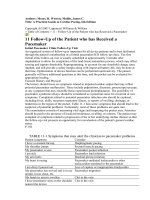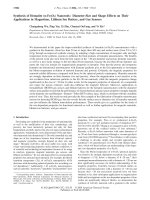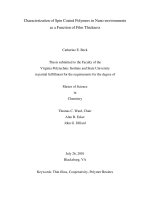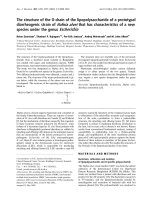Applied of oxide nobles metals has nano size
Bạn đang xem bản rút gọn của tài liệu. Xem và tải ngay bản đầy đủ của tài liệu tại đây (105.75 KB, 2 trang )
Application of oxide nobles metals nano-size
as catalysts for biomass conversion reactions.
Huynh Thanh Cong, Trương Thanh Ngọc, Nguyên Thuy Đoan Trang,
Đao Pham Duy Quang, Ho Son Lam
Institute of Applied Materials Science
Oxide metals has been nano size synthesized with solution of Me(NO3)
2
macerated in to
porous of carbon active and heated in stream inert gas Argon by 550
0
C. The result partition
data parsing with X-Ray find the Me(NO3)
2
were converted to format ZnO , PbO , Pb
2
O; CuO
and Cu
2
O. Survey samples by SEM show the size of these oxides are from 50-100 nm.
The results of analysis of products in gas phase reactions by GC/MS showed isomer
reaction can occur on a carrier such as activated carbon or humic acid, but the by product is
very high. When the presence of metal oxide nanostructures in the composition of the carrier,
content of by- products reduced significantly, from 21% to 2- 4%. Conversion increased while
the selectivity also increases. Special case of the Cu- oxide carried in activated carbon were
appear out reactions dehydrogenation closed ring. while the carrier is humic acid, not only
occurs dehydrogenation round, but also play to promote oxidation reactions in conditions of non
oxygen atmosphere.
On the base catalyst samples obtained were survey responses of biomass conversion into
organic compounds in the vapor phase. Product analysis results, indicating that form a number
of organic compounds such as ethanol, acetic acid, Propionic acid.
I. BACKGROUND:
Coal, oil, natural gas is the material basis for human development for over three
hundred years. There may be many ways to explain the formation of coal, oil, gas, but the
hypothesis of a buried biomass through geological changes seemed acceptable. Thus,
over more billions of years, under the influence of temperature, pressure, biomass was
made up of coal, oil and gas reserves.
The question for scientists in the world that can promote the transformation of
biomass into liquid hydrocarbons in artificial conditions is not? Many works have been
published that can be done, however, so far it remains just a dream, because in fact, there
was no work is applied in practice.
In a review of "History of the bio-oil Hydro processing" published in the journal
Energy & Fuels, No. 21 (2007) [1], Douglas C. Elliott has over 73 abstract works in the
past 25 years and shows, with many models and technologies of different catalysts-all
stop at the pilot form with a capacity of 10-100kg of dry biomass per hour .
There are many reasons for the above works cannot get to practice. In our opinion, some
following problems may be the main causes:
The first reason is the energy to produce liquid hydrocarbons from biomass is
greater than energy gained.
The second reason is the major component of biomass such as cellulose,
hemicellulose, lignin is less soluble in common solvents, so the process of technological
transformation of these substances difficult. Some form of ionic solvents can dissolve
them but the price is too great and the ability to recover almost no solvent.
The third reason is transform biomass into synthesis gas as Methane, Carbon
dioxide, Hydrogen for further conversion into liquid hydrocarbons in petrochemical
technology that can be done but requires more steps and consuming energy.
Hydrogenated vegetable oil to get liquid hydrocarbons is no better solution than
using it as current as biodiesel. Bio-ethanol away from starch using biotechnology have
been put into production, but affect food security, so now many countries are focusing on
building up the industrial chain bio-ethanol production from biomass.
Transform biomass into sugars and then into ethanol solution of 10-15% using
biotechnology to produce bio-ethanol has been studied and applied in actual production,
but this technology requires further evidence 10-15% solution of ethanol distilled into
ethanol, 96%, meaning that consume energy. Moreover, not 100% biomass is converted
into sugar, but also a massive lie in the form of solid waste.
Thus, the study of biomass conversion into liquid hydrocarbons to produce the
new generation fuel, called “sun fuel” - still many issues to be addressed. That was our
goal. Some initial results of the research is presented in the following experiment.
II. EXPERIMELTAL SECTION:









